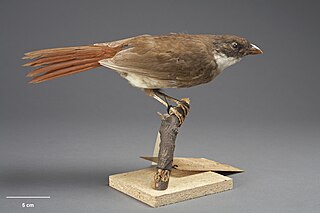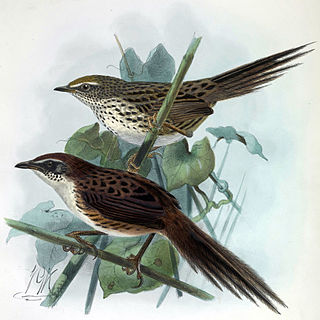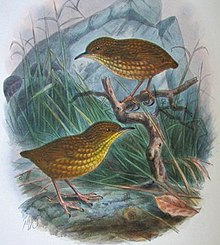
The New Zealand wrens are a family (Acanthisittidae) of tiny passerines endemic to New Zealand. They were represented by seven Holocene species in four or five genera, although only two species in two genera survive today. They are understood to form a distinct lineage within the passerines, but authorities differ on their assignment to the oscines or suboscines. More recent studies suggest that they form a third, most ancient, suborder Acanthisitti and have no living close relatives at all. They are called "wrens" due to similarities in appearance and behaviour to the true wrens (Troglodytidae) but are not members of that family.

The bushwren, also known as the mātuhituhi in the Māori language, was a very small and almost flightless bird that was endemic to New Zealand. It had three subspecies on each of the major islands of New Zealand, the North Island, South Island, and Stewart Island / Rakiura and nearby smaller islands. The species disappeared gradually after the introduction of invasive mammalian predators, last being seen on the North Island in 1955 and the South Island in 1968. Attempts were made to save the remaining population on small islands off Stewart Island, but they ultimately failed with the death of the last remaining known birds in 1972.

Stephens Island is at the northernmost tip of the Marlborough Sounds in the South Island of New Zealand. It lies two kilometres to the northeast of Cape Stephens, the northernmost point of D'Urville Island. The island is 1.5 square kilometres in size, and rises 283 metres (928 ft) high from the sea.

The laughing owl, also known as whēkau, the jackass, or the white-faced owl, is an extinct species of owl that was endemic to New Zealand. Plentiful when European settlers arrived in New Zealand, its scientific description was published in 1845, but it was largely or completely extinct by 1914. The species was traditionally considered to belong to the monotypic genus Sceloglaux Kaup, 1848, although recent genetic studies indicate that it belongs with the boobook owls in the genus Ninox.

The South Island piopio also known as the New Zealand thrush, was a passerine bird of the family Oriolidae.

The North Island piopio was a passerine bird of the family Oriolidae. The North Island piopio is now considered to be extinct.

The Chatham fernbird is an extinct bird species that was endemic to the Chatham Islands. It was historically known only from Mangere Island, but fossils have been found on Pitt Island and Chatham Island as well. Its closest living relative is the New Zealand fernbird or matata. It was formerly treated as a subspecies of the New Zealand fernbird, but is now widely recognized as its own species. Both fernbirds were formerly placed in their own genus Bowdleria; they were later moved to Megalurus and most recently Poodytes.

The New Zealand rock wren is a small New Zealand wren endemic to the South Island of New Zealand. Its Māori names include pīwauwau, mātuitui, and tuke. Outside New Zealand it is sometimes known as the rockwren to distinguish it from the unrelated rock wren of North America.

The austral snipes, also known as the New Zealand snipes or tutukiwi, are a genus, Coenocorypha, of tiny birds in the sandpiper family, which are now only found on New Zealand's outlying islands. There are currently three living species and six known extinct species, with the Subantarctic snipe having three subspecies, including the Campbell Island snipe discovered as recently as 1997. The genus was once distributed from Fiji, New Caledonia and Norfolk Island, across New Zealand and southwards into New Zealand's subantarctic islands, but predation by introduced species, especially rats, has drastically reduced their range.
The long-billed wren is an extinct species of New Zealand wren formerly endemic to the South Island of New Zealand. It was the only species in the genus Dendroscansor. It shares the name "long-billed wren" with the Brazilian bird Cantorchilus longirostris.

Xenicus is a genus of birds in the family Acanthisittidae. It contains New Zealand wrens.

The South Island stout-legged wren or Yaldwyn's wren is an extinct species of New Zealand wren, a family of small birds endemic to New Zealand.

The long-legged bunting is an extinct flightless species of bunting. It was distinguishable by its long legs and short wings, and it inhabited Tenerife, one of the Canary Islands. It is one of the few flightless passerines known to science, all of which are now extinct.
Henry Hammersley Travers was a New Zealand naturalist, professional collector and taxidermist. He was the son of the politician William Travers.

Pachyplichas is a genus containing two extinct species of New Zealand wren, a family of small birds endemic to New Zealand.
The North Island stout-legged wren or Grant-Mackie's wren is an extinct species of New Zealand wren, a family of small birds endemic to New Zealand.

Cats are a popular pet in New Zealand. Cat ownership is occasionally raised as a controversial conservation issue due to the predation of endangered species, such as birds and lizards, by feral cats.

The Murchison Mountains are a group of mountains in Fiordland National Park in New Zealand. It is the location where the South Island takahē, a type of bird presumed extinct, was rediscovered in 1948. The highest mountain is Mount Lyall at 1,892 metres (6,207 ft).

The Stephens Island / Takapourewa lighthouse is one of New Zealand most powerful lights with a range of 18 nautical miles. Perched 183 metres (600 ft) up, on top of Stephens Island, it guards Cook Strait and Tasman Bay / Te Tai-o-Aorere, at the top of the South Island / Te Wai Pounamu.The light flashes white once every six seconds from a white cast iron tower.





















